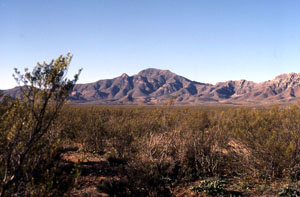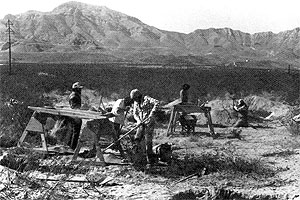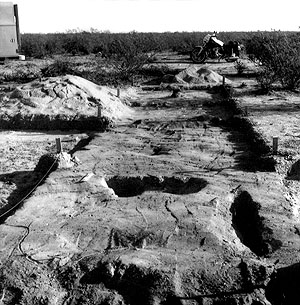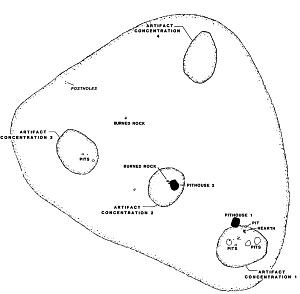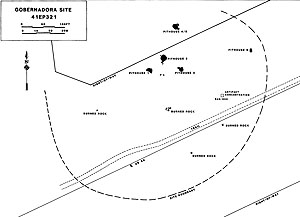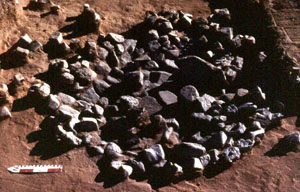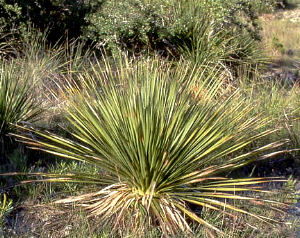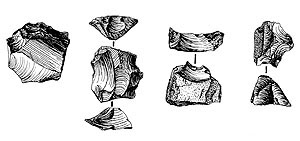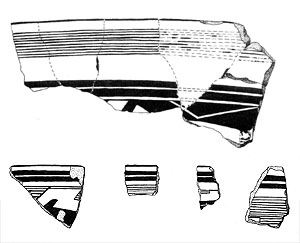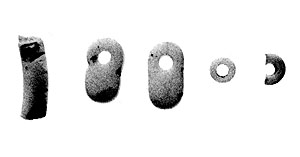Ojasen and Gobernadora
The Ojasen (41EP289) and Gobernadora (41EP321) sites are small prehistoric pithouse villages located on the lower slopes of an alluvial fan piedmont of the Franklin Mountains, near the northern limits of the city of El Paso. They were built some 1000 years ago by hunter-gatherers with a fairly mobile settlement system and seasonal resource procurement strategy. The villages served as winter base camps and plant-processing stations for the desert succulents so necessary for survival during the colder months when other plant resources were scarce and animals lean. During winter and early spring, plants such as sotol store large amounts of nutrients in their hearts, or bases, making them a more valuable food source. Ojasen and Gobernadora proved to be significant sites both for their architecture as well as their well-preserved botanical remains.
The sites lay in the planned construction right-of-way of the US 54 North-South Freeway and were first excavated by the Texas State Department of Highways and Public Transportation (now TxDOT) in 1973. They were further excavated by the El Paso Archaeological Society (EPAS) between 1979 and 1981, and by TxDOT in 1981 and 1983. Additional fieldwork was carried out in response to pending construction of drainage facilities by the University of Texas at El Paso in 1984 and the Cultural Resources Management Division (CRMD) of New Mexico State University in 1986, with field work directed and reported by Myles R. Miller. In 1999 Harry Shafer of Texas A&M University published a report that contains his analysis of the 1981 TxDOT excavations and complements earlier reports on the sites.
By studying the rim design styles on the Mimbres ceramics from the sites and comparing them to Mimbres ceramics from well-dated sites (a process known as ceramic cross-dating), Shafer estimates that Ojasen dates to A.D. 1000–1150 and Gobernadora to A.D. 1000–1200. Ceramic cross-dating, particularly with Mimbres ceramics, can be very accurate, often more so than radiocarbon dating. Radiocarbon assays were also taken from the sites which confirm Shafer's estimates.
These dates place both sites in the early Doña Ana phase of the Formative period. The Doña Ana phase (A.D. 1000–1275) is a period of transition between the informal architecture and mobile settlement system of the Mesilla phase (A.D. 200–1000) and the agriculturally-dependent puebloan settlements of the El Paso phase (A.D. 1275–1450). The early Doña Ana phase (A.D. 1000–1150) is sometimes considered a terminal extension of the Mesilla phase, because the adaptations that characterize it more closely resemble those of the late Mesilla phase than of the late Doña Ana phase.
Gobernadora consists of six pithouses. Three are clustered together to form an arc, two stand side by side a short distance away, and one stands alone. This arrangement may be deliberate, or the arc of pithouses may have been used at a different time or by a separate residential group than the other pithouses. Ojasen is the smaller and more poorly preserved of the two pithouse villages. It consists of a cluster of three pithouses and a solitary pithouse a short distance away. It is not clear whether the cluster of pithouses and the solitary pithouse were occupied simultaneously or at different times.
The pithouses at Ojasen and Gobernadora were square in shape and built in shallow pits. They had frameworks made of dried agave stalks covered with grass, and roofs made of agave stalks that may have been capped with earth or adobe. Square pithouses such as these are common throughout the late Mesilla phase and entire Doña Ana phase. Like most pithouses, those at Ojasen and Gobernadora were not substantial enough to have served as permanent residences and were more likely used as winter base camps. This allowed their seasonal residents to take advantage of the desert succulents and other plants that become concentrated on the slopes of the Franklin Mountains during the cooler months.
Burned rock features found near the pithouses are likely the remains of earth ovens that would have been used to process these plants. Though common throughout the Mesilla and early Doña Ana phase, earth ovens became larger and more widespread during the late Doña Ana phase. Some of the burned rock features at Ojasen and Gobernadora are superimposed over the remains of the pithouses, suggesting that the sites continued to be used as plant-processing stations even after the pithouses were abandoned in the late Doña Ana phase.
Ojasen and Gobernadora have some of the largest macrobotanical inventories in the entire Trans-Pecos region. Thousands of charred plant remains have been recovered from the burned rock features and pithouse fill of the sites. These remains consist almost entirely of wild plants, such as prickly pear, hedgehog cactus, strawberry cactus, cholla, sotol, mesquite, screwbean, cheno-ams, purslane, tansy-mustard, milkvetch, and hackberry.
Corn was the only cultigen identified at the sites, and it makes up only a tiny fraction of their botanical assemblages. This dearth of cultigens is consistent with the pattern for Mesilla and early Doña Ana phase sites. Before A.D. 1150, the people of the western Trans-Pecos relied heavily on wild plants and grew cultigens only as a supplimental resource. The faunal assemblages of Ojasen and Gobernadora are much sparser than their botanical assemblages. They are dominated by the remains of jackrabbits and cottontails, but also include pronghorn, deer, and mountain sheep.
The people of Ojasen and Gobernadora produced expedient, technologically simple chipped-stone tools from local raw materials. Their mobile lifestyle required tools that were flexible enough to serve a variety of functions, but could be discarded when no longer needed. The groundstone tools found at Ojasen and Gobernadora, on the other hand, were heavily reused and maintained. These tools stayed permanently at the sites, rather than making the seasonal rounds with the campers. The people of Ojasen and Gobernadora also produced El Paso brownware ceramics in the Brown, Bichrome, and Polychrome styles. Like the groundstone tools, these ceramics were left at the sites and replaced as needed from local clays.
Intrusive (non-local) Mimbres Black-on-white ceramics were also identified at Ojasen and Gobernadora. Other artifacts recovered from the sites include bone awls, beads, and a needle, as well as shell pendants, beads, and fragments of bracelets and a tinkler. The shell artifacts are similar in many regards to those from the Mimbres region of southern New Mexico and the Casas Grandes region of northern Chihuahua, and may have originated in these places.
Archeologist Harry Shafer, who analyzed and reported on Ojasen and Gobernadora, holds that certain evidence from the sites suggests that trade occurred between them and the Mimbres region. In addition to ceramics and shell artifacts that may originate in the region, Shafer points to the sites' dearth of corn and lack of storage features as evidence that cultigens were not grown by the people of Ojasen and Gobernadora, but were acquired through trade. Shafer postulates that the people of the western Trans-Pecos visited villages in the Mimbres region to observe plaza ceremonies, participate in feasting, and engage in trade.
Whatever the nature of the relationship that the people of Ojasen and Gobernadora had with the Mimbres region they, like other early Doña Ana phase people, lived in much the same way as their Mesilla phase predecessors. They exploited different resources seasonally and returned to their favored localities year after year where they reused or built over their previous pithouses, replenished their supplies of chipped-stone tools and ceramics, and used earth ovens to exploit familiar resources. During the late Doña Ana phase, this mobile lifestyle gave way to a more sedentary one with formal pithouses, larger earth ovens, and a greater reliance on agriculture for subsistence needs.
Contributed by Carly Whelan based on reports by Myles Miller and Harry Shafer and others cited below.
Sources
Miller, Myles R.
1989 Archaeological Excavations at the Gobernadora and Ojasen Sites: Dona Ana Phase Settlement in the Western Hueco Bolson, El Paso County, Texas. Report No. 673. Center for Archaeological Research, New Mexico State University, Las Cruces.
Miller, Myles R. and Nancy A. Kenmotsu
2004 Prehistory of the Jornada Mogollon and Eastern Trans-Pecos Regions of West Texas. In: The Prehistory of Texas, edited by Timothy K. Perttula, pp. 205-265. Texas A&M University Press, College Station.
Shafer, Harry J., John E. Dockall, and Robbie L. Brewington
1999 Archaeology of the Ojasen (41EP289) and Gobernadora (41EP321) Sites, El Paso County, Texas. Reports of Investigations 2, Center for Ecological Archaeology, Texas A&M University, College Station; Report 13, Archeology Studies Program, Environmental Affairs Division, Texas Department of Transportation, Austin.
